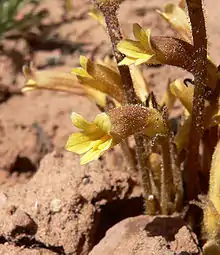Orobanche fasciculata
Orobanche fasciculata is a species of broomrape known by the common name clustered broomrape. It is native to much of western and central North America from Alaska to northern Mexico to the Great Lakes region, where it grows in many types of habitat. It is a parasite growing attached to the roots of other plants, usually members of the Asteraceae such as Artemisia; and other genera such as Eriodictyon and Eriogonum. This plant produces one or more stems from a bulbous root,[1] growing erect to a maximum of about 20 centimeters in height. The stems, leaves and five-lobed flowers are covered by sticky hairs.[1] As a parasite taking its nutrients from a host plant, it lacks chlorophyll as well as a water-storage system.[1] It is variable in color, often yellowish or purple. The inflorescence is a raceme of up to 20 flowers, each on a pedicel up to 15 centimetres (5+7⁄8 in) long. Each flower has a calyx of hairy triangular sepals and a tubular corolla 1.5–3 cm (5⁄8–1+1⁄8 in) long. The flower is yellowish or purplish in color.
| Orobanche fasciculata | |
|---|---|
 | |
| Scientific classification | |
| Kingdom: | Plantae |
| Clade: | Tracheophytes |
| Clade: | Angiosperms |
| Clade: | Eudicots |
| Clade: | Asterids |
| Order: | Lamiales |
| Family: | Orobanchaceae |
| Genus: | Orobanche |
| Species: | O. fasciculata |
| Binomial name | |
| Orobanche fasciculata | |
| Synonyms | |
|
Anoplanthus fasciculatus | |
Uses
Among the Zuni people the powdered plant is inserted into the rectum as a hemorrhoid remedy.[2]
References
- Taylor, Ronald J. (1994) [1992]. Sagebrush Country: A Wildflower Sanctuary (rev. ed.). Missoula, MT: Mountain Press Pub. Co. p. 26. ISBN 0-87842-280-3. OCLC 25708726.
- Stevenson, Matilda Coxe 1915 Ethnobotany of the Zuni Indians. SI-BAE Annual Report #30 (p. 61)
